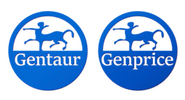Description
SIGLEC8 Antibody | 57-823 | Gentaur UK, US & Europe Distribution
Host: Rabbit
Reactivity: Human
Homology: N/A
Immunogen: This SIGLEC8 antibody is generated from rabbits immunized with a KLH conjugated synthetic peptide between 94-122 amino acids from the N-terminal region of human SIGLEC8.
Research Area: Immunology, Signal Transduction
Tested Application: WB, IHC-P
Application: For WB starting dilution is: 1:1000
For IHC-P starting dilution is: 1:10~50
Specificiy: N/A
Positive Control 1: N/A
Positive Control 2: N/A
Positive Control 3: N/A
Positive Control 4: N/A
Positive Control 5: N/A
Positive Control 6: N/A
Molecular Weight: 54 kDa
Validation: N/A
Isoform: N/A
Purification: This antibody is purified through a protein A column, followed by peptide affinity purification.
Clonality: Polyclonal
Clone: N/A
Isotype: Rabbit Ig
Conjugate: Unconjugated
Physical State: Liquid
Buffer: Supplied in PBS with 0.09% (W/V) sodium azide.
Concentration: batch dependent
Storage Condition: Store at 4˚C for three months and -20˚C, stable for up to one year. As with all antibodies care should be taken to avoid repeated freeze thaw cycles. Antibodies should not be exposed to prolonged high temperatures.
Alternate Name: Sialic acid-binding Ig-like lectin 8, Siglec-8, Sialoadhesin family member 2, SAF-2, SIGLEC8, SAF2
User Note: Optimal dilutions for each application to be determined by the researcher.
BACKGROUND: Sialic acid-binding immunoglobulin (Ig) -like lectins, or SIGLECs (e.g., CD33 (MIM 159590) ) , are a family of type 1 transmembrane proteins each having a unique expression pattern, mostly in hemopoietic cells. SIGLEC8 is a member of the CD33-like subgroup of SIGLECs, which are localized to 19q13.3-q13.4 and have 2 conserved cytoplasmic tyrosine-based motifs: an immunoreceptor tyrosine-based inhibitory motif, or ITIM (see MIM 604964) , and a motif homologous to one identified in signaling lymphocyte activation molecule (SLAM; MIM 603492) that mediates an association with SLAM-associated protein (SAP; MIM 300490) (summarized by Foussias et al., 2000 [PubMed 11095983]) .









![SIGLEC8 Antibody (C-term) [AMM07800G] SIGLEC8 Antibody (C-term) [AMM07800G]](https://cdn11.bigcommerce.com/s-1rdwiq712m/images/stencil/590x590/products/56301/56605/gentaur-genprice__26005.1661610467__29809.1661628092__75433.1661676199__77988.1661684280__64362.1661692443__01339.1661837171.png?c=1)
